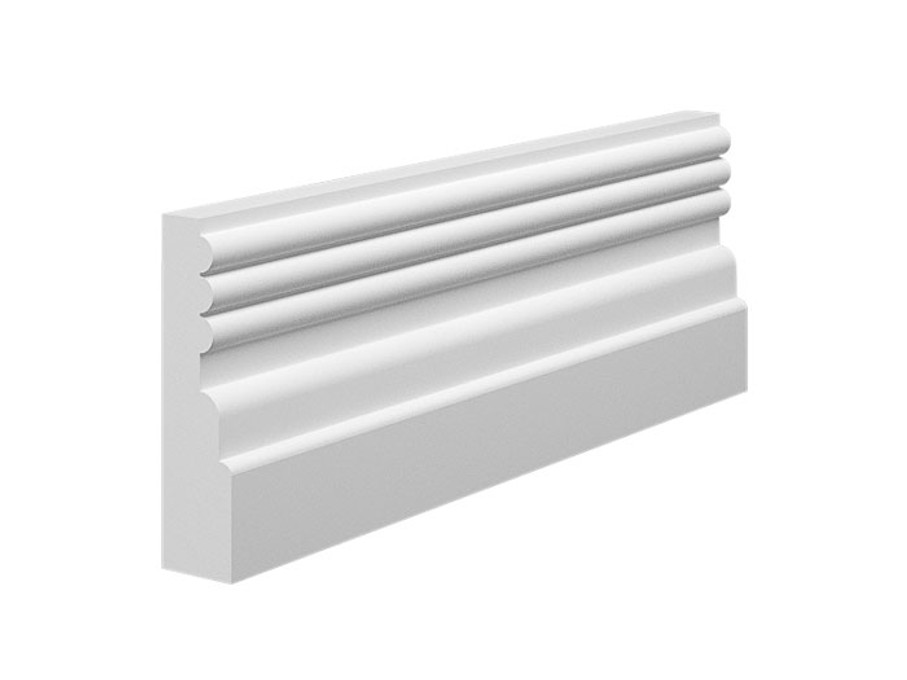
Architrave Buying Guide | Width | Thickness | Length Options
Posted by Lee Watkinson on 29th Aug 2018
Generally speaking, most people will choose an architrave to match their skirting. Luckily enough, we have matching architraves for all of our skirting designs.
When you land on our architrave product pages, you’ll be met with 4 drop down boxes. They contain over 10 different options to choose from.
An option from each dropdown box must be selected before you can add the architrave to the cart.
Now, we’re going to explain all of the selections that can be made.
The Width Option
This option is the first you’ll need to select when you open the product page. It’s an important selection and can be influenced by the height f your skirting in some cases.

When choosing a width, you'll generally see 2 options. However, the options vary depending on the design you are looking at.
Which Width Should You Choose?
If this is a fresh install (you've ripped out all the old architraves), you most likely won't need to match the previous architrave width.
If you're leaving some of the already installed architraves where they are, you'll want to choose the same width so that you have consistency throughout the home.
You should take note of how close your door frames are to our walls. If you have a frame that is very close to a wall, you'll need to measure up to see if your chosen architrave will fit there.
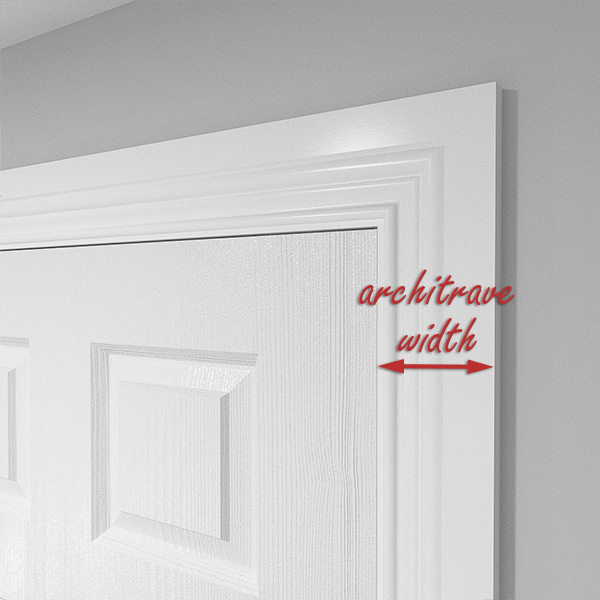
Image showing what the width option changes for architraves
70mm
The most common architrave width we see is 70mm (approximately 3 inches).
This is due to the majority of people having 6 inch skirting or shorter within their homes. 70mm architrave tends to suit skirtings of this height.
95mm
This is the next most common width used for architraves within the UK. 95mm is approximately 4 inches wide.
Generally speaking, as the skirting gets taller the architrave gets wider. We commonly see people using this width with skirtings around 7 or 8 inches tall (170mm or 195mm).
Depending on the design you are looking at, you may be limited to just 95mm. This will be because the design physically cannot fit on a 70mm wide architrave.
120mm
This is the least common architrave width we have available. 120mm is approximately 5 inches wide.
This size is normally used with skirting boards that are 9 inches tall and above (220mm and upwards).
We have a few designs that are limited to the 120mm architrave width due to the sheer size of them - Period, Monarch 1 and Rome to name a few.
The Thickness Option
Once you've selected the desired width for your architrave, the next thing to choose is how thick you want them to be.

When choosing a thickness, you'll see 3 options to choose from. There may be fewer options depending on the design you are looking at.
Which Thickness Should You Choose?
You'll always need to choose the same thickness (or thicker) as your skirtings for your architraves. This is so the architraves don't sit back from the skirting boards.
If you're using plinth blocks between the skirting and architrave, the architrave just needs to be thinner than the plinth block.
We normally recommend using the same thickness for both as this gives the best finish in our opinion.
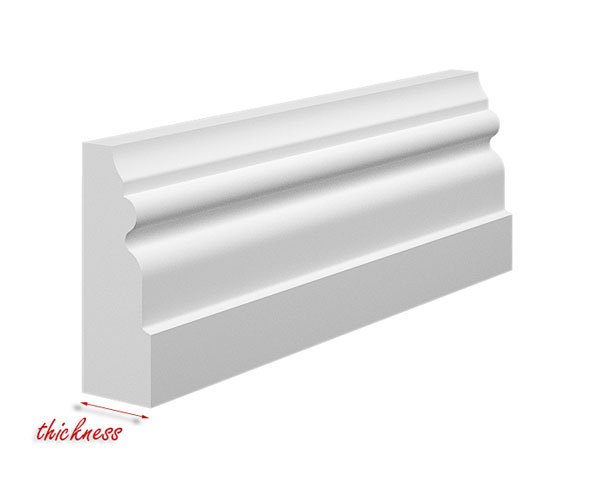
Image shows what the thickness selection changes
15mm Thickness
This thickness is the thinnest we provide as standard. It suits modern designs and helps to save precious floor space within the property.
The boards will also be lighter when using 15mm making them easier to handle during installation.
Because the board is thinner, some of our designs simply won't fit on. Should you not see 15mm as a selection, the design you are looking for won't fit on the board.
18mm Thickness
Out of all the thicknesses, this is the most commonly chosen. This is most likely because it is also the size that is already found in many homes throughout the UK.
The boards will be slightly heavier than their thinner counterparts, but handling should still be fairly easy and manageable.
25mm Thickness
This is the thickest board we offer as standard. This thickness is generally used for wider architraves along with taller skirtings.
As you can imagine, the boards are much heavier due to the increased thickness. All of our designs are able to fit on this size thickness (providing they fit on the width you've chosen!).
The Length Option
Once you've chosen a thickness, it's time to choose your desired length. However, you'll notice that you can choose sets too (more on that below).

When choosing from the choice of lengths (or sets), you'll see 5 options. If you're looking at pine architraves, the choices will be slightly different.
Which Length Should You Choose?
If you decide to order in lengths, you'll choose one of the first 3 options. This way, you'll receive the architraves in the chosen length.
If you decide to order in sets, you'll choose the 4th of 5th option.
We generally find that sets are the most common way in which our customers purchase architraves.
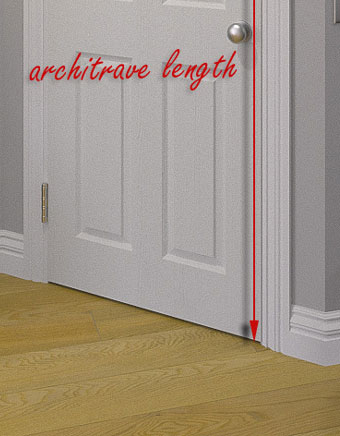
Image showing what the length option will affect
2440mm Length (just over 2.4 metres)
These are the shortest lengths we offer for our MDF architraves (pine can be purchased in 2100mm lengths).
This is the most commonly purchased size for architraves. It allows for wastage and easily covers standard height doors.
If you cut one of these in half (1220mm - just over 1.2 metres), it will also allow for wastage and easily cover a standard width door.
3050mm Length (just over 3 metres)
If you opt for the 3050mm lengths and you have standard size doorways, you'll be able to get 1 leg (architrave on the side of the door frame) and 1 head (architrave on the top the door frame) out of 1 length.
You can achieve this by cutting the desired length for the architrave leg out of the piece.
Then, with the left over piece, simply cut it to the desired length for the architrave head.
4200mm Length (4.2 metres)
These are the longest lengths we have available. If you use these lengths and have standard size doorways, you'll be able to get 2 legs out of 1 piece or 4 heads.
Single Architrave Set
A single set of architrave consists of 2 legs (both 2440mm in length) and 1 head (1220mm in length). This makes them suitable for use with standard size single doorways (a door frame encasing 1 door).
You'll be able to cover one face of a single door frame with a single set. To do both sides, you'll need to order 2 single sets.
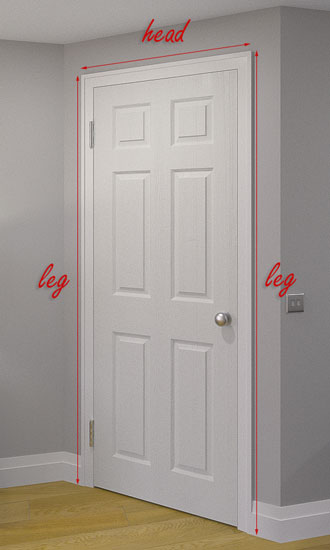
Image shows what 1 single set of architrave will cover
Double Architrave Set
A double set of architrave consists of the same as a single set but the head is longer (includes 2 legs at 2440mm in length and 1 head at 2440mm in length). This makes them suitable for use with standard size double doorways (a door frame encasing 2 doors).
You'll be able to cover one face of a double door frame with a double set. To do both sides, you'll need to order 2 double sets.
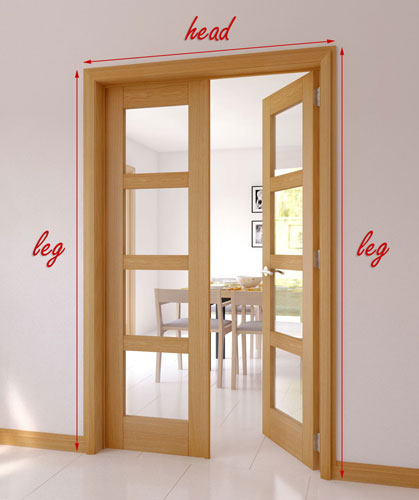
Image shows what 1 double set of architrave will cover
The Finish Option
The final option to choose for your architraves is whether you want them finished or not.

You'll see 2 options to choose from when selecting a finish - unprimed and primed.
Edit: we now offer an undercoated option too!
Which Finish Should You Choose?
We always recommend choosing the primed or undercoated option. We'll go into more detail below.
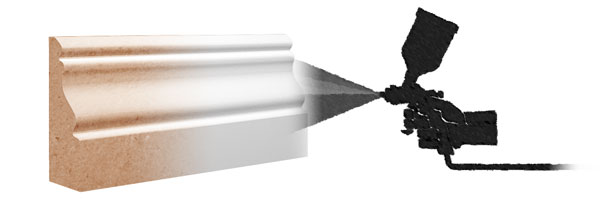
Image showing primer / undercoat being applied to a raw MDF architrave
Unprimed
If you choose to have unprimed architrave, the boards won't have any type of finish applied to them. The sand colour in the picture above will be what you receive.
If you're ordering pine architraves, they'll look like untreated pieces of timber.
When ordering MDF architraves, there are no benefits to having them unprimed. You will need to prime and undercoat them onsite before adding your final paint finish.
If you're ordering pine architraves and you're planning on staining / varnishing them, you'll need to choose the unprimed option.
Primed
When choosing the primed option, you can expect to receive MDF architraves that have a single layer of primer applied to them.
We apply 1 coat of primer (sanding it beforehand) to ensure the best coverage.
Undercoated
If you choose the undercoated finish, you will receive a board that has been sanded, primed, sanded and then undercoated.
This ensures that your architrave will be ready for installation as soon as you receive it! You can add a final paint finish before or after installation if required.
Add Your Architrave To The Cart
So, you've chosen all the options and you're ready to purchase your new architraves!
All you need to do now is type the number of lengths (or sets) you need into the quantity box and hit the 'Add to Cart' button!
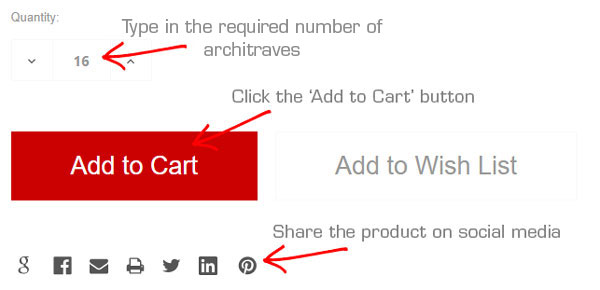

Lee Watkinson
Digital Marketing Director at Skirting World with 10 years of experience in Home Interiors & Manufacturing.







